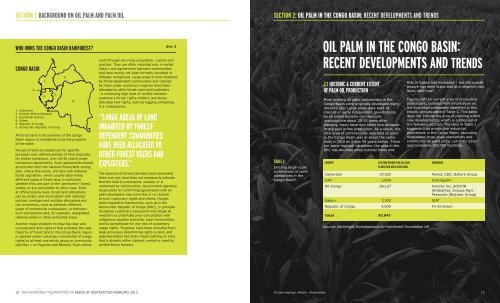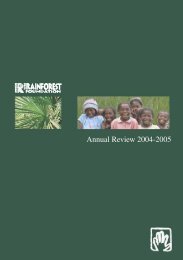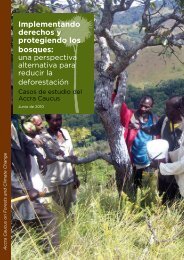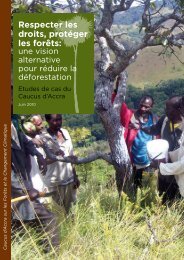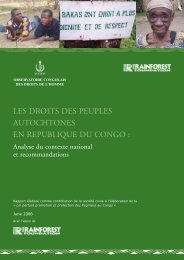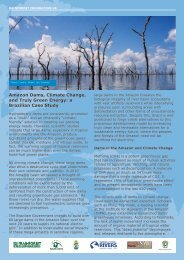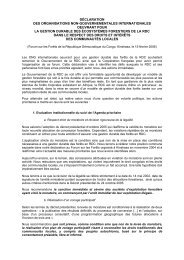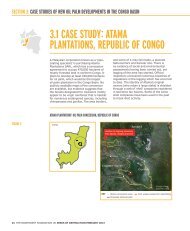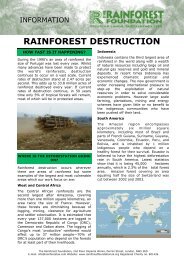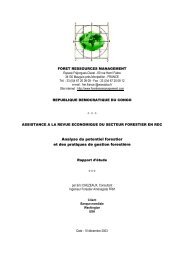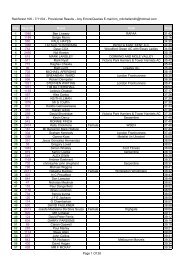Seeds of Destruction - Rainforest Foundation UK
Seeds of Destruction - Rainforest Foundation UK
Seeds of Destruction - Rainforest Foundation UK
Create successful ePaper yourself
Turn your PDF publications into a flip-book with our unique Google optimized e-Paper software.
SECTION 1: BACKGROUND ON OIL PALM AND PALM OIL<br />
SECTION 2: OIL PALM IN THE CONGO BASIN: RECENT DEVELOPMENTS AND TRENDS<br />
WHO OWNS THE CONGO BASIN RAINFOREST?<br />
CONGO BASIN<br />
3.<br />
1.<br />
4.<br />
1. Cameroon<br />
2. Central African Republic<br />
3. Equatorial Guinea<br />
4. Gabon<br />
5. Republic <strong>of</strong> Congo<br />
6. Democratic Republic <strong>of</strong> Congo<br />
All forest land in all countries <strong>of</strong> the Congo<br />
Basin region is considered to be the property<br />
<strong>of</strong> the state.<br />
Parcels <strong>of</strong> land are leased out for specific<br />
purposes over defined periods <strong>of</strong> time (typically,<br />
for timber extraction, over 20-30 years) under<br />
concession agreements. Such agreements should<br />
accord with both the national forest/land zoning<br />
plan, where this exists, and also with national<br />
forest legislation, which usually determines<br />
different types <strong>of</strong> forest land, in particular<br />
whether they are part <strong>of</strong> the ‘permanent’ forest<br />
estate, or are convertible to other uses. Even<br />
at <strong>of</strong>ficial zoning level, forest land allocations<br />
can be erratic and inconsistent with national<br />
policies; overlaps and multiple allocations are<br />
not uncommon, such as between different<br />
types <strong>of</strong> commercial concessions, or between<br />
such concessions and, for example, designated<br />
national parks or other protected areas.<br />
Another major problem in ensuring clear and<br />
uncontested land rights is that probably the vast<br />
majority <strong>of</strong> forest land in the Congo Basin region<br />
is claimed under customary ‘ownership’ <strong>of</strong> usage<br />
rights by at least one ethnic group or community<br />
(see Box 1 on Pygmies and Bantus). Such claims<br />
5.<br />
2.<br />
6.<br />
exist through very long occupation, custom and<br />
practice. They are <strong>of</strong>ten recorded only in verbal<br />
history and agreements between communities<br />
and have mostly not been formally recorded or<br />
<strong>of</strong>ficially recognised. Large areas <strong>of</strong> land inhabited<br />
by forest-dependent communities and claimed<br />
by them under customary regimes have been<br />
allocated to other forest users and exploiters<br />
- a continuing high level <strong>of</strong> conflict between<br />
customary forest ‘rights-holders’ and those<br />
allocated new rights, such as logging companies,<br />
is a consequence.<br />
“LARGE AREAS OF LAND<br />
INHABITED BY FOREST-<br />
DEPENDENT COMMUNITIES<br />
HAVE BEEN ALLOCATED TO<br />
OTHER FOREST USERS AND<br />
EXPLOITERS.”<br />
Box 2<br />
The absence <strong>of</strong> formal (written) land ownership<br />
titles over any land does not necessarily indicate<br />
that the land is unoccupied, unused, or is<br />
unclaimed by communities. Government agencies<br />
responsible for confirming agreements with oil<br />
palm developers may have few or no records<br />
<strong>of</strong> such customary rights and claims, though<br />
some legislative frameworks, such as in the<br />
Democratic Republic <strong>of</strong> Congo (DRC), in principle<br />
recognise customary possession and oblige all<br />
investors to undertake prior consultation with<br />
indigenous peoples and other local communities,<br />
and to compensate for any loss <strong>of</strong> customary<br />
usage rights. ‘Pygmies’ have been excluded from<br />
legal processes determining rights to land, and<br />
sedentarisation has <strong>of</strong>ten meant settling on land<br />
that is already either claimed, owned or used by<br />
settled Bantu farmers.<br />
TABLE 1<br />
Existing large-scale<br />
commercial oil palm<br />
plantations in the<br />
Congo Basin 6 .<br />
OIL PALM IN THE CONGO BASIN:<br />
RECENT DEVELOPMENTS AND TRENDS<br />
2.1 HISTORIC & CURRENT EXTENT<br />
OF PALM OIL PRODUCTION<br />
Most existing oil palm concessions in the<br />
Congo Basin were originally developed many<br />
decades ago. Large areas date back to<br />
colonial or early independent governments.<br />
As oil palms become commercially<br />
unproductive about 20-25 years after<br />
planting, many have now fallen into disrepair<br />
or are past prime production. As a result, the<br />
total area <strong>of</strong> commercially operated oil palm<br />
in the Congo Basin was at about the same<br />
level in 2010 as it was 50 years earlier. There<br />
are some regional variations: the area in the<br />
DRC has declined since colonial times and<br />
COUNTRY<br />
EXISTING PRODUCTIVE OIL PALM<br />
PLANTATION AREA (HECTARES)<br />
that in Gabon has increased – but the overall<br />
picture has been static and at a relatively low<br />
level, until now 5 .<br />
Figures for the current area <strong>of</strong> productive<br />
plantations, collated from information on<br />
the individual companies identified in this<br />
report, are provided in Table 1. This table<br />
does not include the area <strong>of</strong> planting within<br />
new developments, which is addressed in<br />
the following section. The data in Table 1<br />
suggests that productive industrial<br />
plantations in the Congo Basin, excluding<br />
dilapidated large-scale plantations and<br />
community oil palm plots, currently cover<br />
approximately 100,000 hectares.<br />
COMPANIES<br />
Cameroon 57,520 Pamol, CDC, Bollore Group<br />
CAR 1,000 Centrapalm<br />
DR Congo 28,127 Feronia Inc, SOCFIN<br />
(Brabanta), Groupe Agro<br />
Pastorale (Blattner Group)<br />
Gabon 7,300 SIAT<br />
Republic <strong>of</strong> Congo 4,000 Fri-El-Green<br />
Total 97,947<br />
Source: Earthsight Investigations for <strong>Rainforest</strong> <strong>Foundation</strong> <strong>UK</strong><br />
12 THE RAINFOREST FOUNDATION <strong>UK</strong> SEEDS OF DESTRUCTION FEBRUARY 2013 Oil palm saplings, ePhotia - Shutterstock<br />
13


